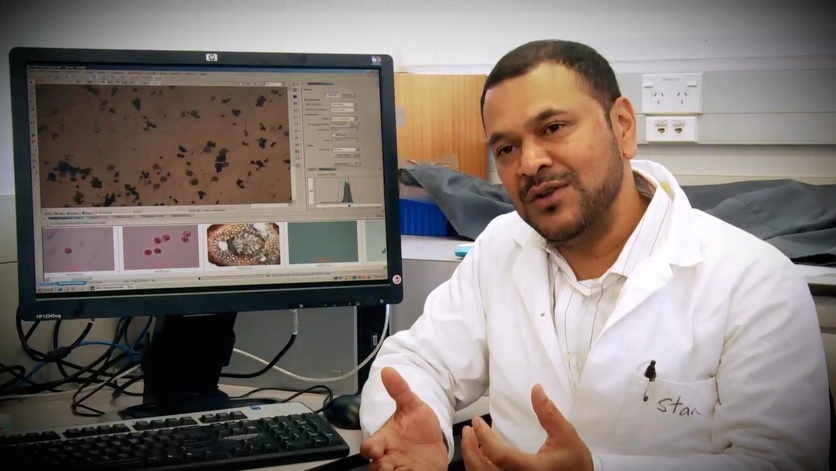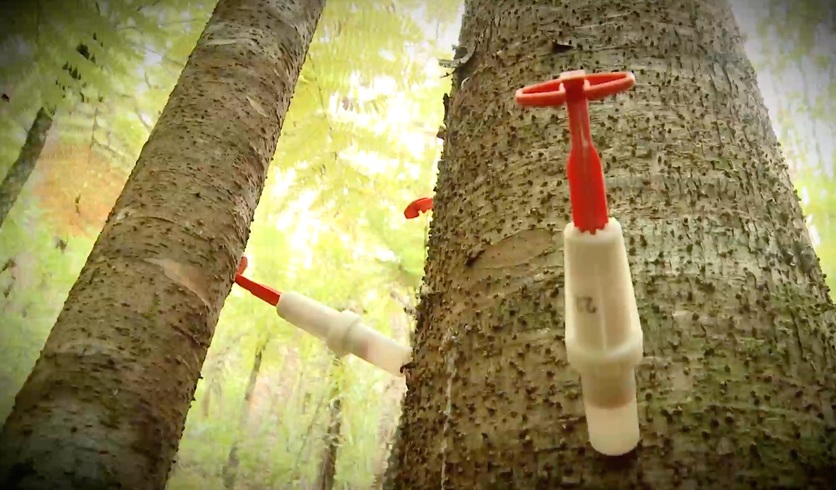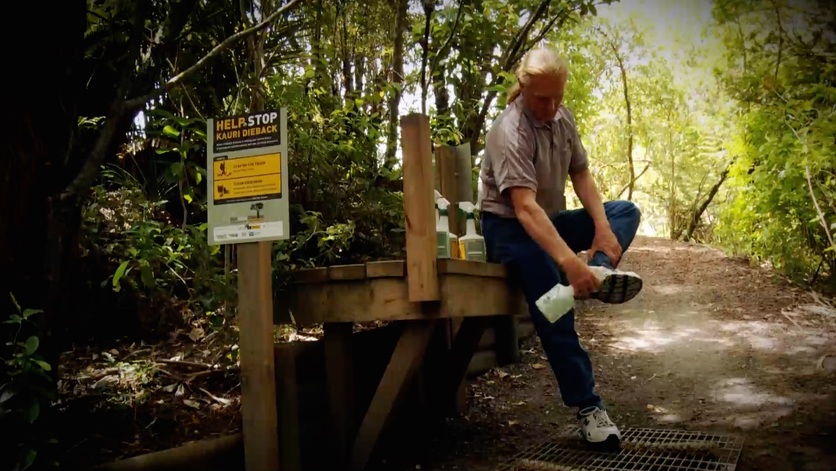Kauri are a tuakana species in Aotearoa – they are like the older sibling, towering above the ngahere (forests), giving protection for the younger organisms.
Kauri forests once covered over a million hectares of Aotearoa, from the Far North to Te Kauri, near Kawhia. The number of kauri trees was reduced substantially by intensive felling during early European colonisation. Today, only about 7,000 hectares remain, and although it’s a protected species, the kauri faces a new and even greater threat.
Kua uru te mate kauri dieback ki ngā ngahere maha o te raki o Tāmaki-makau-rau. Pēra i te Waipoua te tūrangawaewae o te kauri rongonui o te motu – o Tāne-mahuta. (Kauri dieback disease has infiltrated many forests north of Auckland including the Waipoua Forest in Northland, home to our most iconic kauri – Tāne Mahuta.)
Dr Ocean Mercier
Threat of disease
Kauri dieback is a disease caused by a microscopic organism Phytophthora agathidicida that spreads through soil. The disease infects kauri through the roots growing near the surface of the soil. Symptoms include bleeding and gum loss from damage to the lower trunk, yellowing of the foliage, leaf loss and canopy thinning. Nearly every kauri that contracts the disease eventually dies. At this stage, it is believed that P. agathidicida is not native to New Zealand. Genomic research and observation of the locations where it has been detected suggest there have been multiple introductions to New Zealand.
Scientists are increasingly concerned that kauri dieback could actually lead to the extinction of the whole species. This threat has brought together a number of organisations, regional councils and iwi to save the kauri through research, citizen science and community action.
The challenge
Scientists need time to find a way to fight kauri dieback. Preventing the spread of the disease is crucial, so the challenge is how to control it. P. agathidicida spores are in the soil and can cause infection at any time. The spores are spread by people transferring soil from one forest to another, most commonly on their shoes
Strategy
Scientific findings combined with the knowledge of mātauranga Māori are vital to informing decisions on how to combat the spread of the disease. At present, there is no cure to eradicate the disease from New Zealand. The only strategy available at present is to stop it from spreading to areas that are free of the disease.
Research into the biology of the organism, disease detection and spread and ways to combat the disease are ongoing.
Biology of the microorganism
At Manaaki Whenua – Landcare Research in Auckland, Dr Stanley Bellgard was part of a team that identified the pathogen as a new species of Phytophthora. They discovered that P. agathidicida produce oospores (resting spores). These have a tough outer surface and can lie dormant in the soil for more than 3 years. They germinate to form sporangia – structures that produce zoospores. Zoospores are mobile spores that travel through the water in soil. The zoospores of P. agathidicida can sense kauri roots and swim towards them using a tail-like flagella. Zoospores attach to root surfaces and germinate to produce mycelia (long threads), which infect kauri root systems.
Sampling techniques
In the laboratory, P. agathidicida is detected by a bioassay. Pieces of plant material are used as bait to ‘fish’ the P. agathidicida out of the soil. The zoospores of P. agathidicida travel through the water and infect the plant tissue. Scientists then grow the microorganisms on an agar dish. Dr Bellgard says, “The most challenging aspect of this organism is that it is microscopic and remains hidden in the soil. It can only be seen under a compound light microscope.”
Investigating methods to fight kauri dieback
Other research is focused on ways to manage the disease.
Dr Bellgard and his team tested a variety of chemicals including TriGene (now called SteriGENE) and Phytoclean. The different chemicals were tested to assess the efficacy of each in killing zoospores, mycelium and the long-lived, thick-walled oospores that P. agathidicida forms.
TriGene and Phytoclean have been used successfully to manage Phytophthora cinnamomi, a dieback disease in Western Australia. However, Stanley’s research showed that a 2% solution of TriGene and 10% solution of Phytoclean will kill the mycelium and zoospores of P. agathidicida but not the oospores.
Using spray solutions like TriGene to control P. agathidicida works well on boots and equipment, but using it around the tree would also kill beneficial microorganisms and so is not an option there. There are many other organisms in the soil that live with and benefit kauri, so the team have to be very selective about how they go about managing this disease.
Dr Ian Horner from Plant & Food Research is investigating other ways to fight P. agathidicida. He trialled the use of phosphorous acid (phosphite). Phosphite has been used in the horticultural industry for treating trees with similar Phytophthora diseases. First, the scientists calculate the volume of phosphite that the tree might require based on its size. They estimate one injector for every 200 mm of circumference. Holes are drilled into the tree, and the phosphite is injected into the tree.
Dr Horner and his team started with glasshouse trials using kauri seedlings, which were deliberately infected with the P. agathidicida pathogen. Next, some trees were treated with phosphite and some were not. The untreated trees all died within a few weeks of inoculation. The majority of the trees injected with phosphite survived. However, a kauri forest is a totally different system, so in 2012, new trials were started on larger kauri trees to help to determine appropriate treatment regimes. To date, the work is progressing well, with younger trees recovering from signs of dieback. However, Dr Horner does caution that, although the results are exciting so far, with the phosphite actually stopping the spread of the disease inside the tree, it’s still only “a bandaid” and the kauri will need to be retreated as the treatment doesn’t eradicate the pathogen.
Research on disease spread by the Auckland Council Biosecurity team, Plant & Food Research and scientists at three universities investigated the idea that pigs were spreading the disease by ingesting diseased plant material containing spores. The outcome was that pigs are likely to be a relatively minor cause of spreading kauri dieback disease in their poo, and humans remain a key culprit in the spread of the spores. However, more research is required to quantify the role pigs might play in spreading the disease through soil on their trotters and snout.
For those of us that are working with this challenge, it affects us at a spiritual level. From a Māori point of view, these kauri are our brothers, we whakapapa back to the same place.
Ian Mitchell
Research led by Victoria University of Wellington, in collaboration with iwi has discovered that some compounds found in kānuka cause an immediate loss of movement of the infectious spores of the microbe that causes kauri dieback disease. This means that these compounds could stop this pathogen from moving through soil and infecting kauri trees.
Nature of science
When faced with a challenge like finding a cure for a new disease, scientists draw on both existing knowledge and new ideas to find solutions. Often these solutions are a mixture of old and new technologies and knowledge. Individually and as communities, we all have a part to play in helping not to spread the disease.
What can you do to stop the spread?
Our tūpuna were very careful about how you went into and came out of the forest. You made sure that you were clean when you went in, you made sure you were clean when you came out, and you did that not only physically but in terms of cleaning your wairua and all of those things as well
Hori Parata
There are some simple actions we can all take:
- Make sure shoes, tyres and equipment are cleaned to remove soil and plant material before and after visiting any kauri forest.
- Use cleaning stations installed on major tracks, scrub all footwear to remove soil and spray with the disinfectant supplied.
- Stay on the tracks and avoid walking over kauri roots.
- Adhere to rāhui placed by mana whenua on different forests and tracks.
- Get involved in community action and citizen science projects to stop the spread of the disease – for example, Kauri Rescue.
- If you see any signs of infected trees, alert the national kauri dieback team on 0800 NZ KAURI.
Related content
Read this article to find out more about the impacts of deforestation.
Find out why cultural indicators are so important to Māori in this video.
Activity ideas
Learn about food webs within our native forest in this activity.
Explore this timeline looking at some of the historical aspects of hidden taonga in our native bush.
The Connected journal has an article about kauri dieback. It is intended for level 4 readers and has useful teacher support materials.
Useful links
For more information about kauri dieback and how you can help further, see the official kauri dieback website.
The Waikato Regional Council has a simple animation and further information to understand more about kauri dieback.
In a world where mātauranga Māori is often still ignored and undermined, this video The fight to save kauri with mātauranga Māori from Re: News, explores how simply using it is half of the battle and how the traditional knowledge of soil is helping to rebuild the forest’s resilience to kauri dieback.
Listen to this 2018 podcast from Plant & Food Research in which Dr Ian Horner discusses kauri dieback disease and his research to help save the iconic taonga species.
Computer technology measures forces behind kauri dieback explains how Dr Volker Nock uses a special computer chip to measure how the fungal spores drill into kauri trees.
Visit RNZ for an Our Changing World article and interview on the hunt for kauri trees resistant to kauri dieback. The article contains links to additional information about the disease.
Scion, a Crown research institute, is looking for resistant strains of kauri. Read their articles Understanding kauri whakapapa in fight against dieback disease and Fighting back with science.
Acknowledgement
Project Mātauranga
Watch Series 2/Episode 10: Kauri Dieback: Death in the Ngahere
Project Mātauranga is a television series that investigates Māori world views and methodologies within the scientific community and looks at their practical applications. Each of the 13 episodes in series 2 shows how western science and Māori knowledge systems are combining to provide solutions to a variety of challenges.
The Science Learning Hub thanks Scottie Productions for allowing us to host these videos.




